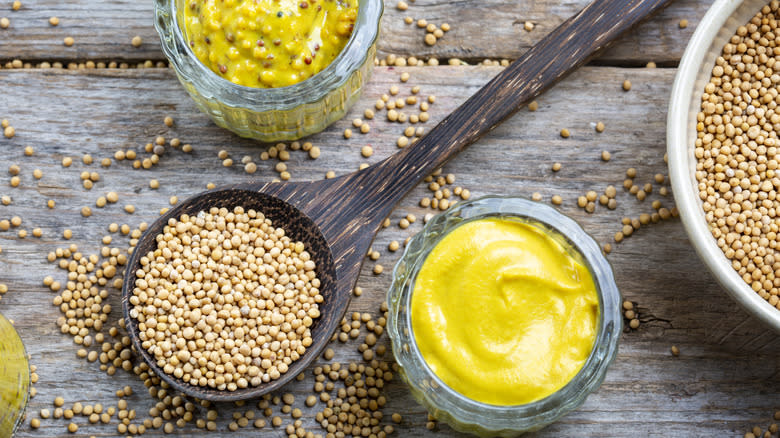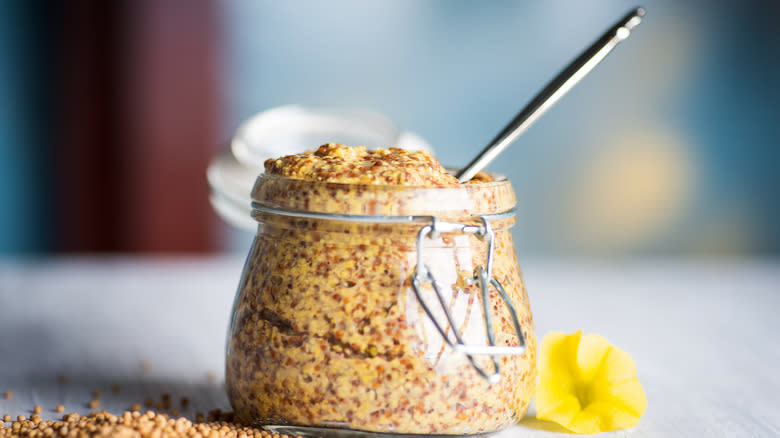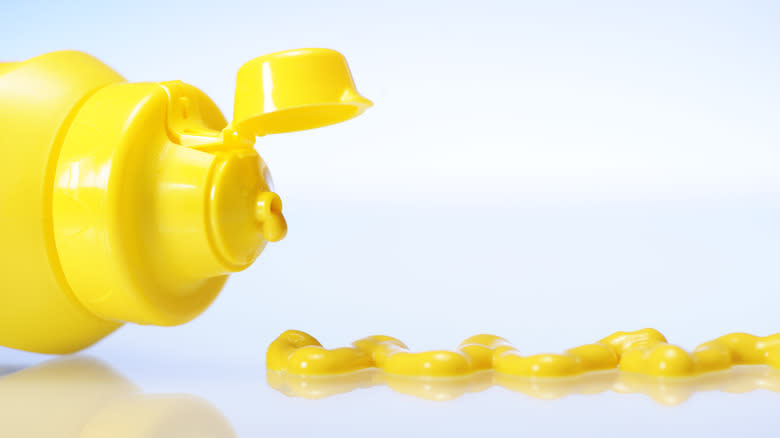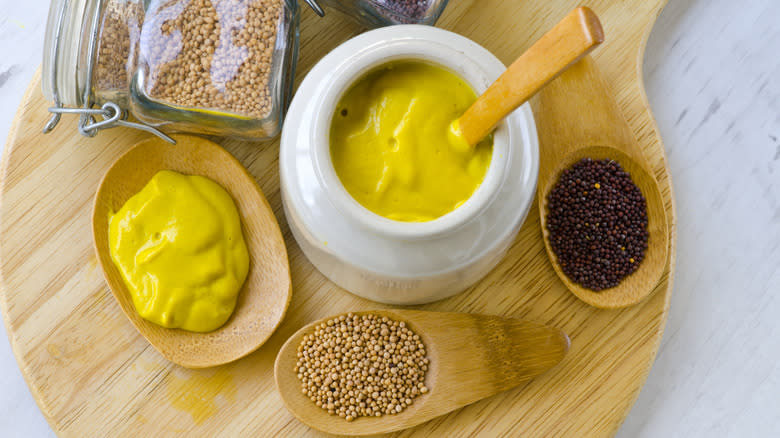The Difference Between German And American Mustard

When it comes to garnishing hot dogs and other foods, a classic question arises-- ketchup or mustard? Yet, while the former sweet tomato paste is very uniform, there are many types of mustard. When gazing at a grocery store shelf, selecting the ideal mustard may feel intimidating. All are delicious, but specifically for a sausage garnish, two varieties stand out: German and American mustard, which couldn't be more different.
German renditions of the condiment typically call for whole mustard seeds, while the iconic American yellow variety only utilizes powdered mustard. This style sources seeds with a yellow hue, which boasts a distinct spiced flavor that makes American mustard relatively standard. Conversely, German mustards utilize varying mustard types, include a broad range of additional ingredients, and comprise indeterminate textures. As a result, the style is much less definite in its components and taste -- it ranges from sweet to very spicy. Let's dive into the details.
Read more: 25 Most Popular Snacks In America Ranked Worst To Best
How Is German Mustard Made?

Mustard is a popular condiment in Germany, with many regional variations throughout the country. As a result, German mustard doesn't allude to one set style but rather a collected range of recipes. Such condiments encompass a spectrum of palates -- often imbued with extra ingredients -- which lend notes from sweet to spicy. Therefore, the production method of German mustard heavily depends on its origin.
The most noted type, consumed across the country, is called Mittelscharf. It packs a bit more punch than dijon, a flavor achieved through a mix of both yellow and brown mustard seeds, which are whole. To craft such a condiment, the ingredients -- varying spices and vinegar -- sans mustard seeds are heated on a stove. Next, all components are melded in a bowl for around a day before blending to a consistency ranging from chunky to smooth. Spicier variants incorporate horseradish for pungency, while in Düsseldorf, they use milder vinegar and spicier mustard seeds for a bolder effect.
In Bavaria, mustards are known for their sweeter character. Such a quality is achieved through additions like sugar, honey, and applesauce, complemented with a wide range of aromatics like cloves, allspice, onions, and more. Texturally, this mustard is on the coarser side, which is also achieved by manually grinding the mustard seeds before dissolving them in vinegar. This mustard is melded for around an hour before blending, much shorter than mittelscharf.
How Is American Mustard Made?

Lots of mustards are consumed in the U.S.; however, the name typically refers to the iconic yellow variety. Its vivid color arises due to the dual punch of yellow mustard seeds and turmeric, which are melded into a thick yet uniform paste. The condiment starts with seeds already in powdered form, which are turned into a smooth texture through the use of wondra flour blended into vinegar and water. Slight deviations occur in the utilized additional spices; paprika and garlic powder are common additions, while some also use onion powder, cinnamon, and honey.
Like German mustards, this yellow variety is crafted on a stovetop; however, all ingredients are briefly boiled and then simmered for up to ten minutes. Such a move thickens the consistency -- then the mustard is allowed to cool before storage. The straightforward assembly process, complemented with more standard ingredients, means yellow mustard exhibits a dependably pungent but not bold flavor.
German Vs. American Mustard Culinary Uses

As fragrantly flavored condiments with attractive colors, both mustard styles do well as garnishes on top sausages, hot dogs, and burgers. Due to German mustard's range of flavors, double-check the style before purchasing -- not everyone would like a sweeter Bavarian variant atop a hot dog. Conversely, American mustard offers a more dependable, balanced flavor, which makes it harder to substitute in another variety. For the closest flavor analog, seek out a milder Mittelscharf.
An array of traditional German dishes utilize German mustards specifically, which are difficult to substitute. Yogurt salad dressings rely on the pungency of homemade mustards, while dishes like Grünkohl and Pinkel -- kale and sausage stew -- are tastier with the intact mustard seeds. Yellow mustard is a less dominant culinary addition, its flavor functions well in everything from vinaigrettes to marinades and eggs. It lends a creamer consistency to sauces, especially in comparison to grainer German types. As a result, don't substitute a more pungent variety; it can throw off the flavor balance of a dish.
Read the original article on Tasting Table.

